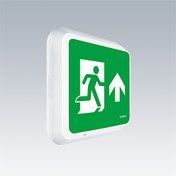Voyager Square / VOY SQUARE 220 P MSW ECC WH SP1-E002-UP
96635053
▼ Data Sheet
A slim, square, surface mounted, LED safety sign luminaire. Luminaire for central emergency light supply, with circuit monitoring, without single monitoring of the luminaire. NFC interface for maintenance via PROset Pen (article: 22170290) or PROset app. Power supply: 220-240 Vac (± 10%), 50/60 Hz; 176-280 Vdc. Body: injection moulded polycarbonate, white (RAL 9016). Diffuser: opal polycarbonate, with glued, printed emergency exit direction arrow (up) pictogram according to ISO 7010. Uniform backlighting of pictogram, luminance > 500 cd/m² in the white region and 200 cd / m² on average in mains mode (according to DIN 4844), 2 cd / m² minimum in emergency mode (according to EN 1838). Recognition distance according to EN 1838: 44m. Class II electrical, IP65, Impact strength: IK10. ambient temperature: -30°C to +35°C. Suitable for direct mounting to wall. Loop-in, loop-out is possible for cables up to 2.5 mm². BESA compatible. Food certificate (to be used in areas with fully packaged food). Luminaire wired with halogen free and silicone free leads. Luminaire with D symbol (for use in environments in which the accumulation of conductive dust on the luminaire can be expected).

